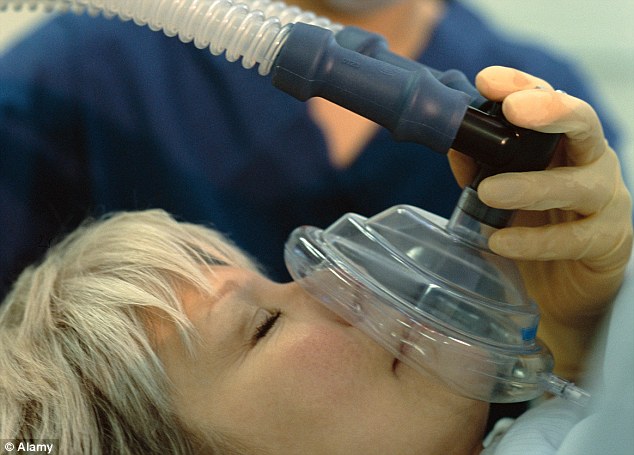The gases used to knock out surgery patients are accumulating in Earth’s atmosphere, where they make a small contribution to climate change, report scientists who have detected the compounds as far afield as Antarctica. Over the past decade, concentrations of the anaesthetics desflurane, isoflurane and sevoflurane have been rising globally, the new study finds.
Like the well-known climate warmer carbon dioxide, anesthesia gases allow the atmosphere to store more energy from the Sun. But unlike carbon dioxide, the medical gases are extra potent in their greenhouse-gas effects.
One kilogram (2.2 pounds) of desflurane, for instance, is equivalent to 2,500 kilograms (5,512 pounds) of carbon dioxide in terms of the amount of greenhouse warming potential, explained Martin Vollmer, an atmospheric chemist at the Swiss Federal Laboratories for Materials Science and Technology in Dubendorf, Switzerland, who led the new study. “On a kilogram-per-kilogram basis, it’s so much more potent” than carbon dioxide, he said.

In a new scientific paper, Vollmer and his colleagues report the 2014 atmospheric concentration of desflurane as 0.30 parts per trillion (ppt). Isoflurane, sevoflurane and halothane came in at 0.097 ppt, 0.13 ppt and 0.0092 ppt, respectively. Carbon dioxide — which hit 400 parts per million in 2014 -is a billion times more abundant than the most prevalent of these anesthetics. The team did not include the common anesthesia nitrous oxide in the study because it has many sources other than anesthetics. The team’s anesthesia-gas findings have been published online in Geophysical Research Letters, a journal of the American Geophysical Union.
The researchers obtained their numbers by collecting samples of air from remote sites in the Northern Hemisphere since 2000, as well as aboard the icebreaker research vessel Araon during an expedition in the North Pacific in 2012 and at the South Korea Antarctic station King Sejong in the South Shetland Islands. They have also been tracking the anesthetics since 2013 in two-hourly measurements at a high-altitude observatory at Jungfraujoch, Switzerland, and from ongoing air sampling from a rooftop in a suburb of Zurich, Switzerland.
To turn these air samples into their global emissions estimates, the data were combined with a two-dimensional computer model of atmospheric transport and chemistry. The results are the first so-called top-down estimates–based on actual atmospheric measurements–of how many metrics tons of each anesthetic were released into the atmosphere in 2014. That can now be compared to “bottom-up” estimates by other researchers, which estimate atmospheric concentrations based on factors such as how much of each gas is sold annually, how much typically escapes through operating room vents and how much is not metabolized by patients.

Although anaesthetics are small players in overall human-generated greenhouse emissions, they are a growing matter of concern to many in the health-care industry. Anaesthesia gas abundances are growing and should not be overlooked, said Yale University School of Medicine anesthesiologist Jodi Sherman, a reviewer of the GRL paper.
“Health care in and of itself in the U.S. is one of the worst polluting industries,” she explained. “It generates 8 percent of U.S. greenhouse gases according to one study. Add to this the fact that climate change has been recognized by the World Health Organization as the number one health issue of the 21st century, and it behooves us to do a better job with emissions.”
Anesthesia gases are something that the health care industry can easily do something about, Sherman added. Dropping desflurane, for instance, would make sense because it is the most potent greenhouse gas of the bunch. Not all anesthesiologists agree with that strategy, however.

“What the report fails to note is that a major factor determining the environmental effect is the manner in which the anesthetics are used,” said anesthesiologist Edmond Eger of the University of California at San Francisco. “Many anesthetists deliver sevoflurane or isoflurane in a two — three liters per minute flow but deliver desflurane in a lower flow — 0.5 to one liter per minute …. Some believe that desflurane has clinical advantages that argue for its continued use.”
“There’s nothing unique about desflurane that we can’t do with other drugs,” Sherman countered. “Desflurane we could live without, and every little bit makes a difference.”
Story Source: The above story is based on materials provided by American Geophysical Union. Note: Materials may be edited for content and length


I may need your help. I tried many ways but couldn’t solve it, but after reading your article, I think you have a way to help me. I’m looking forward for your reply. Thanks.
Thanks for sharing. I read many of your blog posts, cool, your blog is very good. https://accounts.binance.com/pt-PT/register?ref=JHQQKNKN
Your point of view caught my eye and was very interesting. Thanks. I have a question for you.
Thank you for your sharing. I am worried that I lack creative ideas. It is your article that makes me full of hope. Thank you. But, I have a question, can you help me?
Can you be more specific about the content of your article? After reading it, I still have some doubts. Hope you can help me.